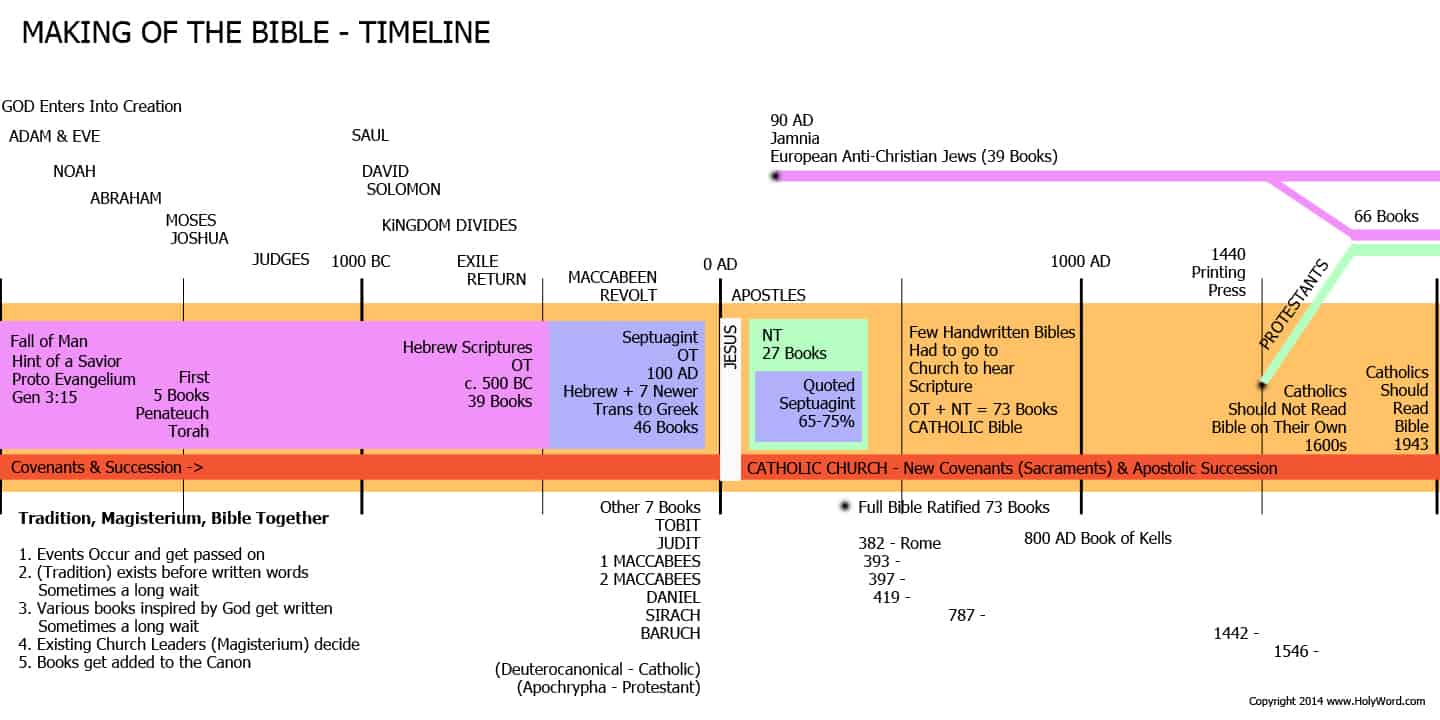Like many people, the first time I picked up the Bible I thought it was a single book. It was bound together under one cover and had a table of contents. But then I found out God didn’t give the completed works all at once to one of His prophets.
The Bible is a library of books. Even though God is the source Author who inspired people to write, the books were written by various writers with varying styles over thousands of years. It didn’t come with a table of contents. Someone had to decide which books to include or leave out.
Let’s look at how the books came together into one Bible...
One question we will need to look at is how were the books decided upon? Was it a democratic decision, or a decision by one person? If you asked a group of today’s historians which books of the Bible they would include, or the Jews which books they would include, or the early Gnostics which books they would include, or Christians which books they would include, each group would likely come up with a different list (or canon) of books.
- A Canon is a measuring stick, in this case, the authentic list of books.
In addition to the books that were included in the Bible, many were left out, so the question of who has the authority to decide is important.
Not Left to Chance
God did not leave that to chance. From the beginning of His creation with the first people (with Adam and Eve), His promise continued faithfully and was tied to a promised succession. We can follow this succession in the Old Testament through the genealogies.
We may recognize a few names like Noah, Abraham, and Moses, but there are many more and they are not there by accident. They record the promise of God with His people, from the beginning to Jesus.
Stay on the promised line
If we stay on the line of succession, we can identify an authentic list of books. If we stray away from it and let others outside of this authority decide, we run into many alternate opinions and lose the ability to retain unity.
Modern example: A company creating a product doesn’t ask a competitor to write their product’s instruction book. It would be foolish. The competitor would have no interest in supporting their rival and might even include opposing info.
Likewise, God didn’t authenticate people outside of His people to decide what is in the Bible. The competitors would have no interest in preserving its content and the truths it teaches.
The genealogies in the Bible help us stay on track… we will mention some of the famous people who were on the promised line or prophets in union with them. We’ll start with…
- Adam & Eve, Seth… Noah… Abraham.
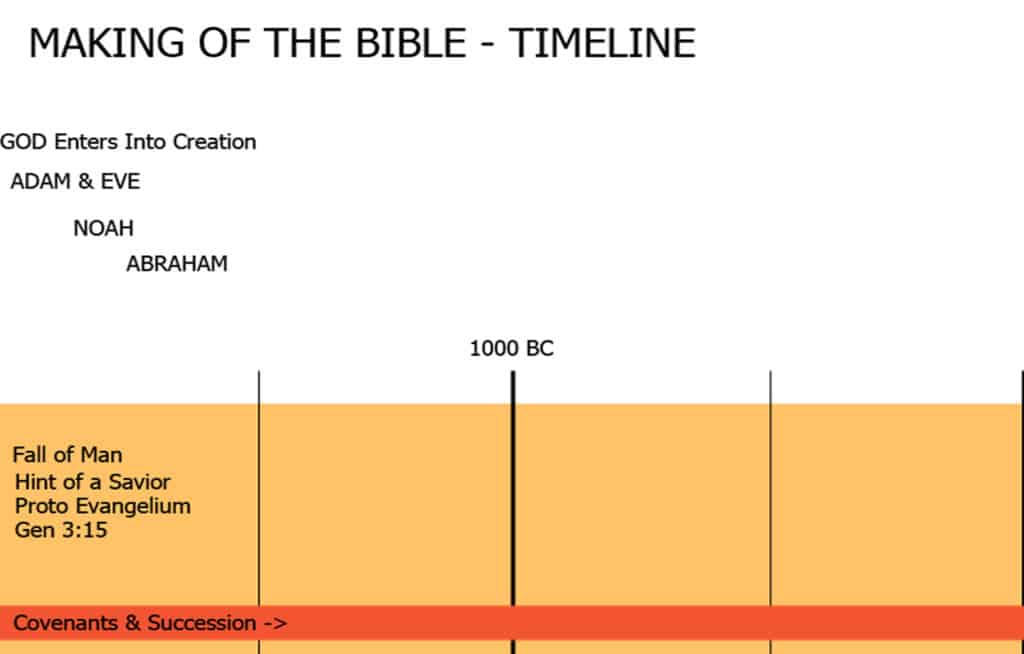
Not A Human-made Monarchy
Some might think succession is like a monarchy where people are just guarding their own human power. Here is a key difference.
How many human institutions do you know that have lasted continuously from early written history until now? The answer is Zero.
However, God’s plan of succession has existed continuously. It is not a human monarchy started in some arbitrary year and destined to fail.
Even the Roman empire lasted only about 1,000 years, but that is short compared to the timeline of the Bible with the Church.
How is a book added to the Bible?
Four-Fold approach
As the Bible gets created we see this 4 fold approach of
- 1) The events occurring,
- 2) The verbal Tradition,
- 3) The writings,
- 4) The decision to include or exclude them in the canon.
- God Reveals and Events come first
God reveals Himself and the events occur. A person was not dictating the events on paper in real-time as they occurred. The events simply occurred first. - Tradition Comes Next
After the events occurred, they were passed on verbally. Some of the lesser events were not passed on beyond the day. - The Traditions are written down.
Some interesting events and those including essential teachings were retained and eventually written down. - Existing leaders decide
Of the written traditions, the leaders of God’s people (in the line of succession) decided which writings to include and which not to.
Note: Some books were written immediately, but still required a decision by the Church leaders for inclusion or exclusion.
Let’s jump ahead to see some books getting added…
- Abraham, Isaac, Jacob(Israel), Judah… Moses
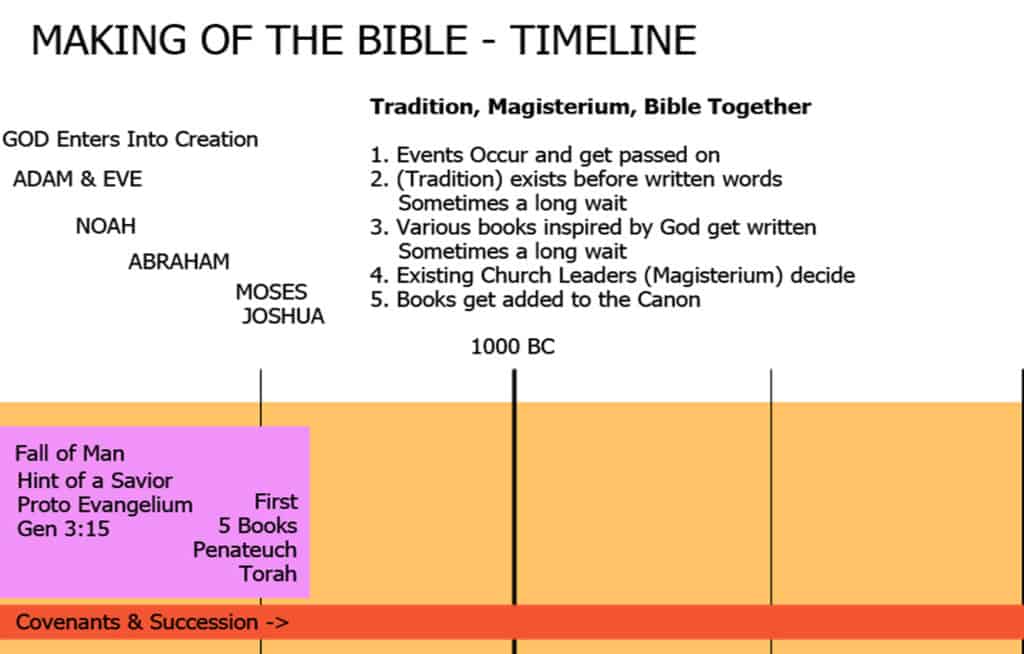
The First 5 books
The first 5 books of the Bible are called the Pentateuch (Greek) or Torah (Hebrew) These are a collection of traditional events and earlier writings, believed to have been compiled together into 5 books around the time of Moses. Ex 17:14, 24:4, 34:27 ; Numbers 33:1-2 ; Deuteronomy 31:9-11
Note: Not all ancient writings were included, so we are already seeing discernment and authority in decisions to determine the canon.
Time Period of the first 5 Books
Exodus, Numbers, and Deuteronomy mention there were scrolls placed next to the Ark of the Covenant in Moses’s day. Moses lived roughly in the 1200-1400 time frame.
The exact date is not critical, but we can establish the process of adding books to the bible occurs with real people and real events. However, it is not unusual for the process to take centuries.

Why Only 5 Books and not 60+?
The Scriptures were not all written at the same time. More events are coming so let’s jump ahead some more.
- Moses… David, Solomon… Judah Kings… (into Babylonian Exile)
As we continue following the promised succession through the line of Judah through David and Solomon, and through the Kings of Judah, we reach the period of the Babylonian Exile. By this time we have 39 Hebrew Scriptures but they have not been officially decided upon yet.
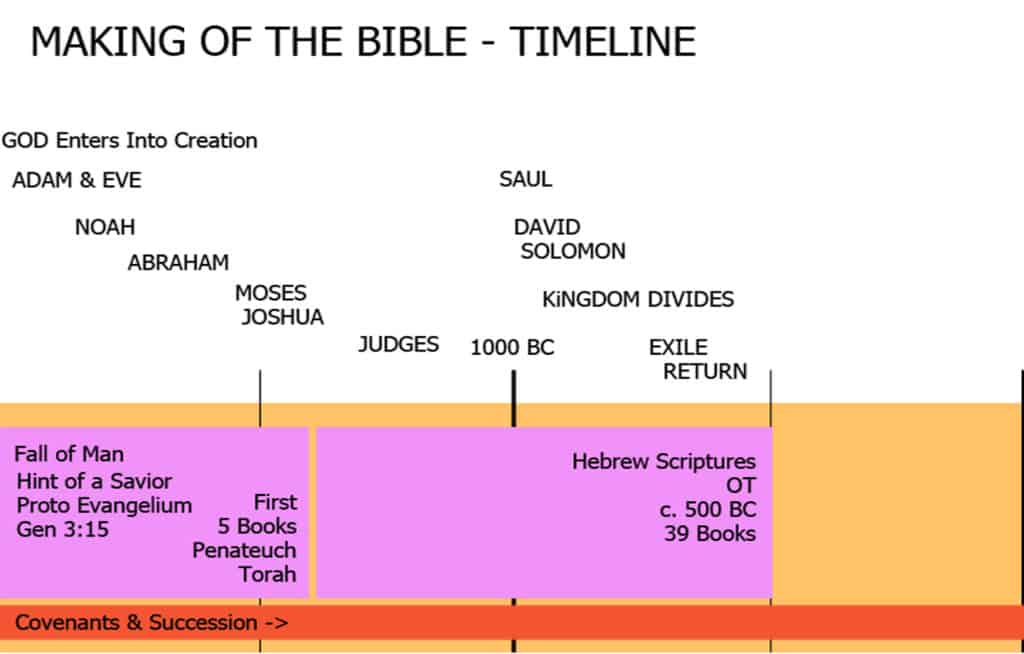
We will make a note here that these are the Hebrew Scriptures, other languages have not been introduced to the Bible yet.
During the Captivity period of Babylon, the Israelites (now referred to as Jews) started speaking Aramaic. Also, the Greek Empire was spreading and Greek was becoming the common language of that part of the world.
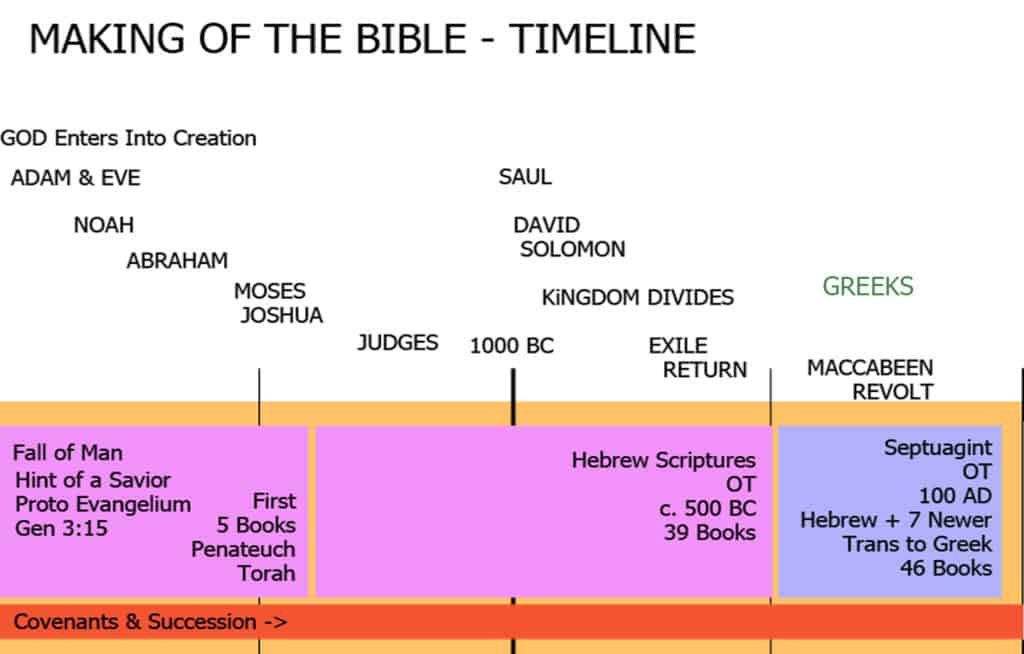
Septuagint Greek Bible
In the centuries between the Captivity period and Jesus, additional books were written in Aramaic. Then the entire Hebrew Old Testament, including these newer books were translated into Greek, called the Septuagint version, named after the 70 scribes who translated it from the Hebrew and Aramaic into Greek.
- The Succession continues through the Tribe of Judah… to Joseph/Mary and to Jesus
When we reach Jesus, although the Septuagint is in use, the canon of the newer books has not been decided yet.
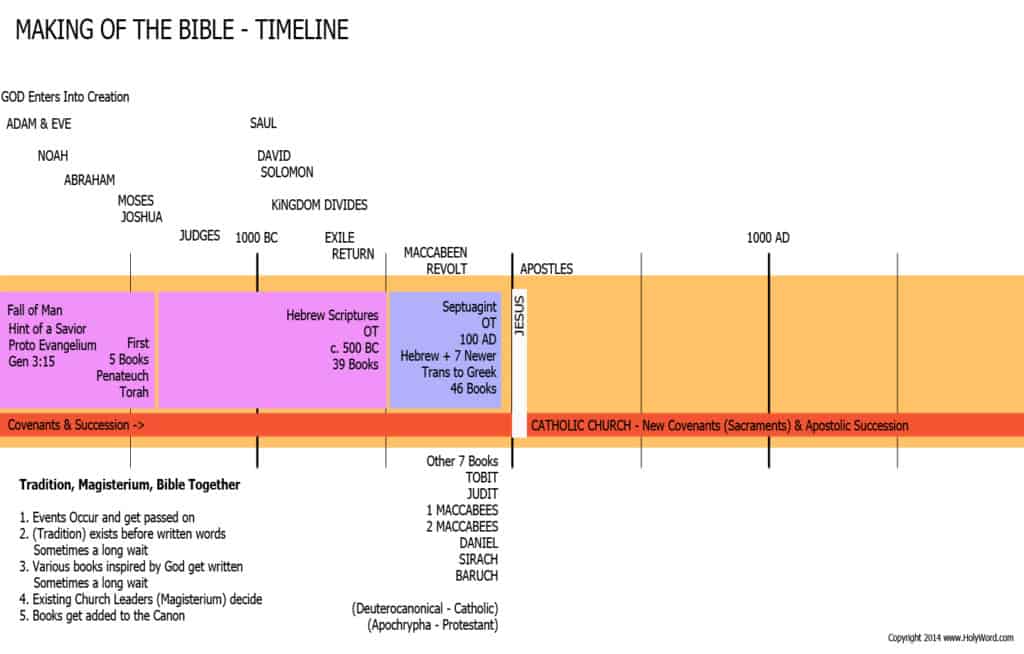
Jesus
How can we possibly say enough about Jesus here? We can’t. Jesus is God and is the reason for the Bible.
For now, we will mention that the line of succession in the genealogies helped us prove our way from God’s plan in Genesis to Jesus. He is the ultimate Authority.
Authority and Succession did not end with Jesus.
Jesus chose 12 Apostles to preach and lead the Church. He sent the Holy Spirit to help guide them.
Jesus, Peter & the Apostles… Succession continues
Apostolic Succession
Jesus did not abolish the OT succession. He fulfilled it and continued it by choosing 12 Apostles with Peter as the lead shepherd. From here on out, they are the Church with Jesus’ God-given authority.
- Church leaders will be necessary to decide which future books are included or not.
The Credibility of the Septuagint
The Apostles and New Testament writers quoted from the Greek Septuagint frequently, roughly 2/3 of the time compared to the Hebrew OT 1/3 of the time. We are not seeking the exact percentage here, but it shows the Septuagint was acceptable to the Apostles and Apostolic writers of the New Testament.
- Since the Apostles used both the Hebrew and Greek Septuagint OT while writing the New Testament, that gives both translations high credibility for use by Christians going forward in canon decisions.
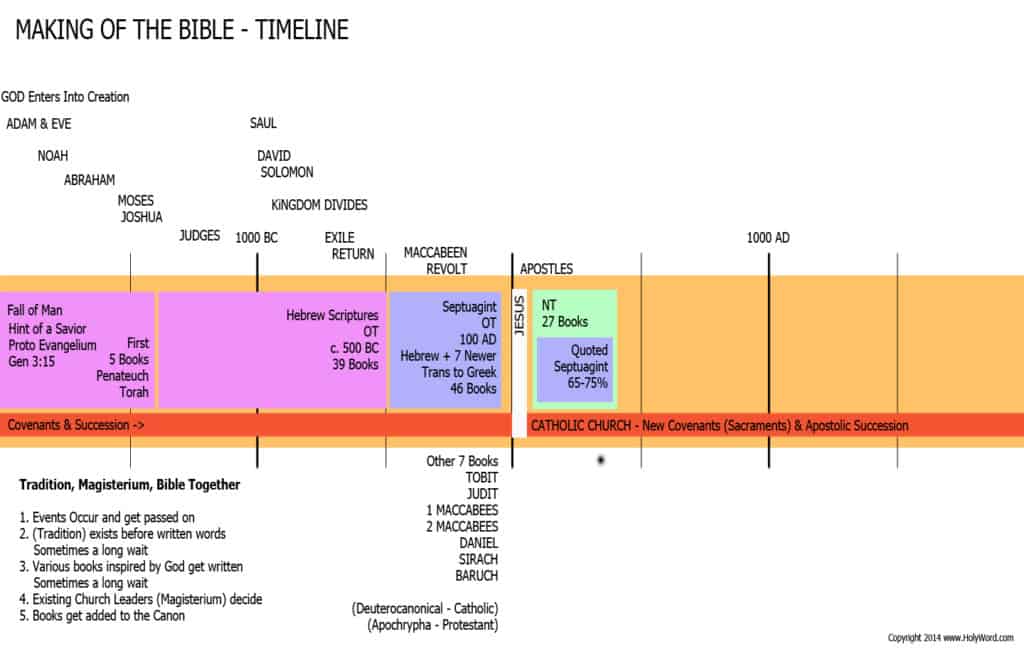
Variance over 7 Books
Since there is some variance in modern Bibles over whether these 7 Septuagint books are included in the canon, let’s start with some of the Jewish histories.
Jamnia
Some say there was a Jewish council around 90 AD in Jamnia to determine which Old Testament books were to be part of the Jewish canon. Some dispute Jamnia saying the Jewish canon decision was made centuries later.
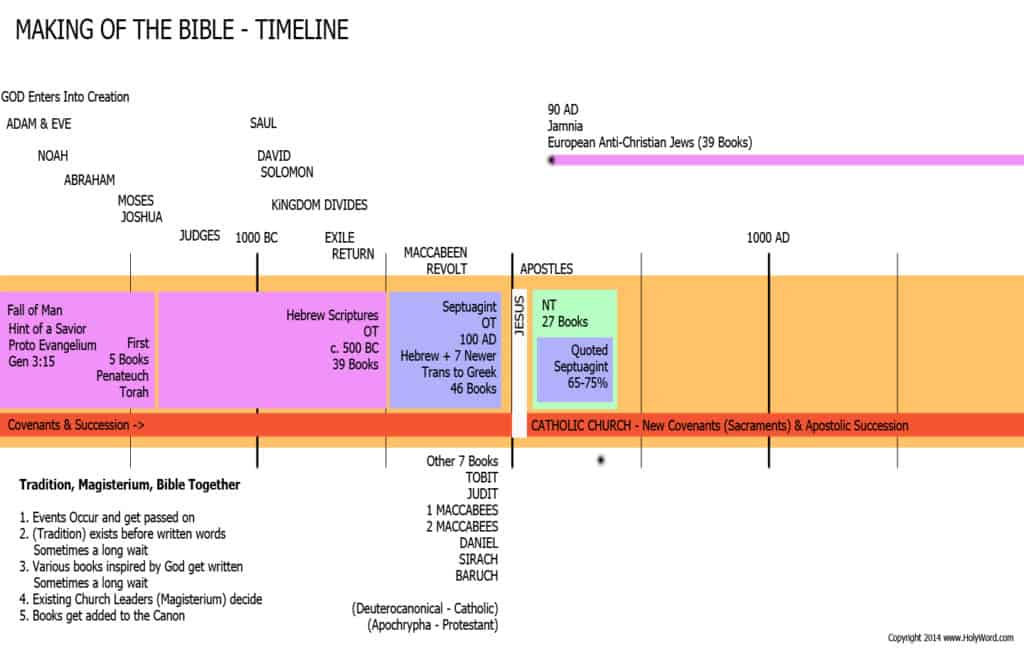
For Christians this date does not matter much because between 30-33 AD, the Jews did not recognize Jesus as God and did not accept His teachings. As a result, Christian and Jewish leadership would be separate from that date forward, and their decisions about their canon will differ going forward.
Jewish and Apostles separate Authorities
After Jesus gave His Church to Peter and the Apostles, the Jewish authorities were opposed to His Church.
- The Jews did not believe Jesus was God
- They accused Jesus of Blasphemy and it resulted in His crucifixion
- The Sadducees put Peter and John on trial for speaking in the Temple
- Herod Agrippa killed James the Apostle
- Several Jewish authorities put Paul in jail and on trial
- The Jews did not want more people converting to Christianity
- The Jews had no interest in supporting Christianity
The Jews had no interest in supporting Christianity
The point here is not to disparage Jews then or today. The point is they were not with Jesus or His Church so would have no authority over Christian canon decisions. The books they decided on for their canon would be based on Jewish Theology, not Christian Theology.
It was also not in Jewish Hebrew cultural or religious interests to support Greek, especially after Greeks desecrated their Temple c 167 BC (described in 1 & 2 Maccabees).
Much of the New Testament was written in Greek and provided a convenient continuation from the Septuagint. This could result in even more Jewish converts to Christianity.
Whatever the reasons, the Jews decided only to include the Hebrew Scriptures in their canon; Not the newer Aramaic books, not the Greek Septuagint, and not the New Testament about Jesus.
The pink color shows the 39 books where the Hebrew canon ended, while the Christian canon continued.
(Note: The Jewish canon may have a smaller count of books as some books were split into smaller parts in the Christian canon)

- The Jewish authorities were a separate group from the Christians after Jesus.
Newer Christian canon
We mentioned earlier that God Reveals Himself, the Events occur, then Verbal Tradition, then the Books are Written, and then the Books are decided upon by the existing Church authority. It is the same process as we continue forward…
Jesus and Church Tradition was first
Jesus did not write any books. He sent the Apostles out to preach. The early Church thrived and grew before it had any NT books. Sometimes it is easy for us to think the whole Bible always existed and that is all we need, but Jesus established the Church with His Apostles first. The Bible came later and both support each other.
So we need to follow the Apostles and their succession next…
New Testament was written roughly between 40-90AD.
After the Apostles went out and established the Church in various regions, some of them and their disciples started to record the events of Jesus’ life and the events of the early Church.
Letters to local communities
Some of the letters (like Paul’s letters) were written to specific local communities and at different times. The city of Ephesus had Paul’s letter to the Ephesians first. The city of Corinth had Paul’s letters to the Corinthians first. It would take many decades and centuries for all the communities to get all the letters and treat them equally.
The Bible did not come with a table of contents, so realizing what NT books to add to the Bible took time.
Church under persecution
One factor slowing down the New Testament Canon’s decisions was that the Church was often under severe persecution by the Romans. This made it more difficult for the NT letters to circulate and for Church leaders to have open discussions together.
- After the Edict of Milan in 313 AD, which allowed Christianity in the Roman Empire, the discussion of the NT Canon increased.

Marcion
In the first 2 centuries AD, there had been attempts by various groups and individuals to draw up lists of canons they wanted. Marcion c. 140 AD had distorted beliefs of God. He rejected the entire Old Testament, and only kept Luke’s Gospel and Paul’s letters.
Moratorium fragment
Dated around c 170 AD, it is a fragment that has many of the New Testament books. Although it is not authoritative on canon, it shows some evidence of NT letters growing in popularity and finding a wider audience than their local communities.
Gnostics (2nd/3rd century)
The Gnostics (an early heresy) wanted to add additional books to the Bible that distorted the humanity and divinity of Jesus to their own beliefs; The gospel of Thomas, the gospel of Philip, the gospel of Mary, and the gospel of Peter, were written in the 2nd century or later, falsely taking names of the Apostles.
The Bible did not exist yet to reject the Gnostics. They were rejected by the Church, rooted in the Apostles from Jesus.
Time for a decision
If individuals outside of Apostolic authority could decide canon, then anyone, anywhere, at any time could choose their own books. With this growing problem, it was becoming clear that the Church needed to decide on what was to be included in the canon.
Council of Nicaea 325 AD
About a decade after the legalization of Christianity, an Ecumenical council of the Church was called. The Church was catching up on heresies and concentrated this council on clarifying the Divinity of Jesus, also formulated the Nicene Creed. It would take longer than a decade to determine matters of Bible canon.
Athanasius – Bishop of Alexandria
While there were still numerous opinions in the 300’s, Athanasius was the first to list 73 books around 367AD. His list respected the Apostolic use of both the Hebrew and Greek Septuagint OT; 46 OT books, plus 27 NT books.
Other councils start ratifying the same books
Shortly after Athanasius, several councils of Rome and the Western Church ratified the same canon of 73 books, including councils of Rome 382 AD, the council of Hippo 393 AD, the council of Carthage 397AD and the Latin Vulgate Bible in 405 AD.
Jerome
Some today say that Jerome wanted Septuagint books kept out or marked as Apocrypha (non-canonical). but Jerome writes opposing opinion was not from him, but from Jews that he knew.
Letter Against Rufinus
“I wasn’t relating my own personal views, but rather the remarks that they [the Jews] are wont to make against us”
Jerome’s supports what we concluded earlier, that the Jews were not likely to support any Christian canon. Jerome’s writings to the end of his life indicated complete unity with the Church with loyalty to the Bishops and the Bishop of Rome.
- By the end of the 4th century AD, canon was starting to solidify with the Bishops at various councils.
The Eastern churches
The Eastern churches with a less centralized leadership took longer, but in 787 AD, at the 2nd council of Nicaea, the Greek & Byzantine Church adopted the canon decided at the council of Carthage from 397 AD; 73 books.
Centuries later, In 1442, at the Council of Florence, additional Eastern churches accepted the same canon, 73 books. The Christian Church all seemed unified on the canon.
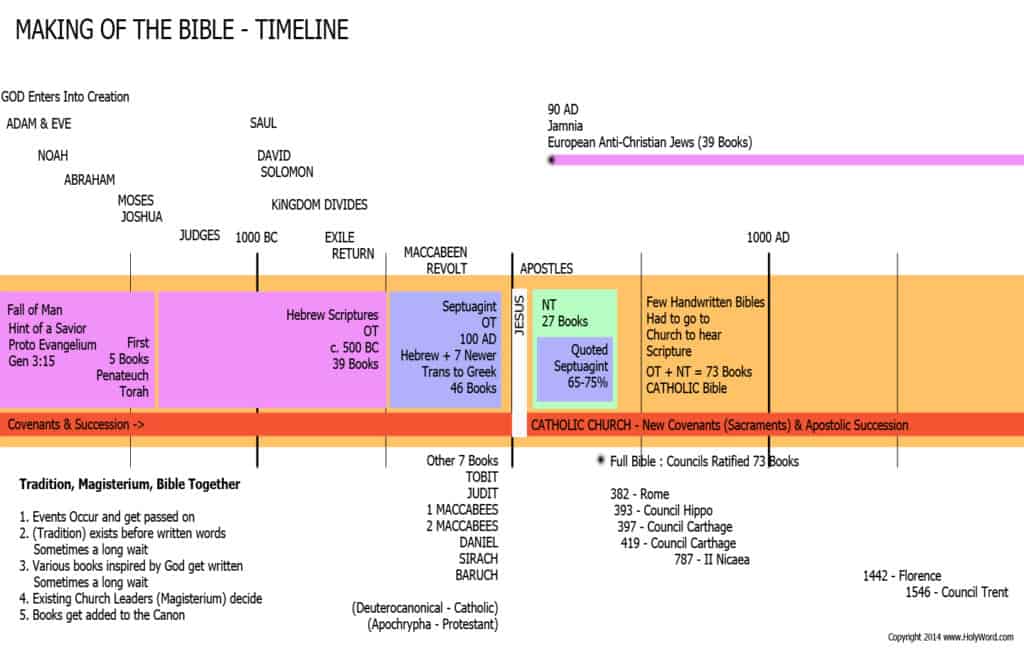
The Printing Press
In c 1440 the printing press was invented. Prior to that, Bibles were handwritten and costly to make, mainly only available at church.
The Printing press changed the landscape. Within 50 years, the common person could own a Bible. Protestant Reformers were not lost on this development and used it spread their ideas.
- Prior to the 1400s very few had a Bible of their own to think all they needed was the Bible without the Church. It was a new idea.
Protestantism attempts to change the canon.
The question of the canon of the Bible had seemed to be settled by the councils ranging from 383 AD through 1442 AD.
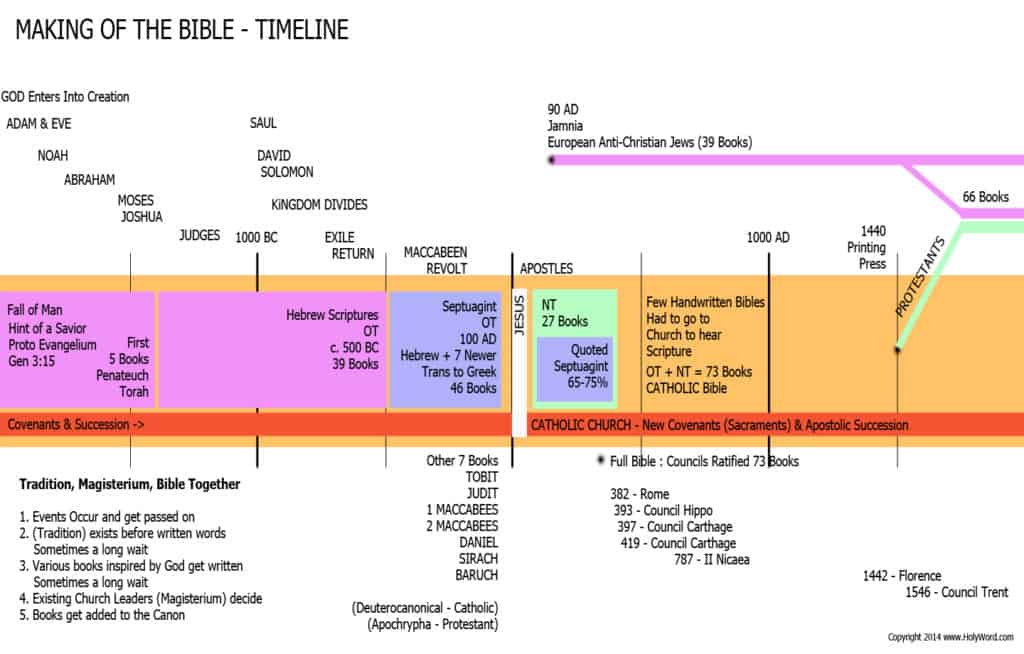
Martin Luther
Martin Luther was an ex-Catholic priest who decided to re-open the debates of the 1st four centuries. With the use of the printing press, Luther side-stepped existing Church authority and printed his own Bible (1522-1534 AD).
Luther followed the Hebrew OT while lowering the importance of the 7 Septuagint books into a separate section called the Apocrypha (not inspired, but good for instruction.)
The Church Responded
The Catholic Church responded with a council in 1546. It was not supportive of re-opening the individual opinion that it had experienced in the first 300+ years AD. Instead, it supported the unity that had been gained through the various councils over the past 1200 years (Rome 382 AD, the council of Hippo 393 AD, the council of Carthage 397AD, Nicaea II of 787, and Florence 1442).
- At the council of Trent, the Catholic Church reaffirmed the 73 books as permanent canon to prevent further individual interpretation of canon.
Late 1700’s and 1800s, 7 books removed.
In the late 1700s and 1800s, some Protestant publishers took an additional step removing the 7 Septuagint OT books altogether. They might have thought that if the books were not inspired canon, there wasn’t a priority to print them. Some Bibles now only have 66 books as a result.
Conclusion.
- In recent years we see more Protestant bibles re-adding the 7 books. That is encouraging. Even Luther said they were good for instruction.
- We recommend finding a Bible with the 73 books. If you only use 66 because that is what you were taught, then at least you can have the other 7 around for good instruction and charitable discussions with others.
- Without the authority of Church leadership in the course of history, much of the canon would never have been decided.
- The good news is that Protestants, Catholics, and Orthodox agreed on 27 NT books and have at least 39 OT books in common which can give us a lot of common ground for discussions.
We hope this gives you some idea of how and when the books of the Bible were added to the canon.
In the Bible, Jesus, the Apostles, Barnabus & Paul, Antioch, Ephesus, Corinth, and the other communities established by the Apostles were all One Church.
We encourage you to read the Bible with charity and pray for the day when all Christian churches can be reunited on the canon.

Other Questions:
Is the Bible Self-Evident in regards to canon (which books to include or not)?
- The Bible started with no books and no table of contents, so it was not self-evident that any books needed to be formed into a Bible. It needed God’s Revelation and His Church to start it.
- Earlier books in the Bible do not reference later books so Relying solely on Self-Evidence at any point could have prevented future books from being added.
- Many uninspired books reference the Bible and the Bible references some sources outside Scripture. As a result, it is not self-evident in which books are inspired by cross-references although some may be helpful.
- The Ethiopian Eunuch in Acts 8 did not understand the book of Isaiah until Philip from the Church explains it. The Bible is not always self-evident.
For More Reading : How to Read the Bible?
Do You Need a Bible? Visit Our Online Gift Store
To Read a Quiet Passage – Click Here

